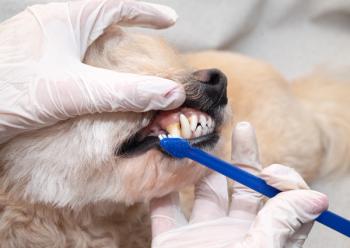
UC Davis treats pug with rare coagulation disorder
Otis, a young pug, was diagnosed with a plethora of health issues at UC Davis, including Hemophilia A
When Otis, a 6-year-old pug, was 2 months old, he was brought to the UC Davis veterinary hospital’s emergency room by his owner Jennifer Newman, "an experienced pug owner." Otis presented at UC Davis with a cough and respiratory issues, and one of his littermates had recently died after presented with similar symptoms. Newman asked the team at the hospital to do a thorough workup, and they discovered Otis had Hemophilia A.
Hemophilia A is a rare, but the most common, severe inherited coagulation disorder in both animals and human beings.1,2 The illness is caused by a deficiency in coagulation factor VIII on the X chromosome, similar to in people, and an essential protein required for normal blood clotting. Canines that have this disease have variable presentations of the disease with mild and moderate bleeding observed in these patients.1 Dogs with Hemophilia A can also bruise easily or have extended periods of bleeding following trauma, sometimes severe enough to cause death. However, if receiving proper care, most affected canines have a normal lifespan.
Otis has received several blood transfusions over the years at UC Davis, which is sourced by UC Davis from local volunteers. UC Davis shared that every week, dogs from the local area come to the hospital to donate blood to help those in need. In 2024, thanks to the donors in its area, UC Davis has transfused more than 850 units of blood.
“Otis is a bit of a celebrity at the hospital,” expressed Steven Epstein, DVM, DACVECC, co-chief of the Small Animal Emergency and Critical Care Service and director of the Transfusion Medicine Service, in an organizational release.1
“He has been an amazing patient throughout all of his stays. I was there when he first came to us as a puppy and have seen him multiple times throughout the years.”
Newman, who was conducting her own investigation into Otis’ condition, discovered a team of scientists at the University of North Carolina that were conducting research into Hemophilia A in canines. She was then able to connect that team to Otis’ team at UC Davis with the researchers at the University of North Carolina to share ideas for his care.
However, Otis’ health issues did not stop with Hemophilia A. Later in his life, he developed a severe inflammation of his esophagus and stomach, which led him to be placed under the care of internal medicine team at the hospital. His issues resulted in him being hospitalized for several weeks and received a stomach feeding tube multiple times to gain control due to Otis regurgitating his food and having bleeding issues.
As if Otis did not have enough health issues, his team at UC Davis found that he had a sliding hiatal hernia during a fluoroscopy swallow test.1 This condition caused a portion of his stomach to move into his esophagus intermittently, which causes him to regurgitate fluid. UC Davis shared that this condition does not always require surgery, but it does in Otis’ case after his condition became problematic in 2024.
According to the release, Otis developed severe esophagitis secondary to acid reflux and regurgitation of food due to multiple aspects of his condition, including the hiatal hernia and bleeding into his stomach. He was hospitalized for a week while his care team provided medical management of his conditions, but his situation was not resolved.
“Although the bleeding predisposition inherent to hemophilia presents substantial complexities for surgical intervention, the correction of the hiatal hernia was considered an important and judicious approach to optimizing Otis' overall condition,” said Max Randolph, DVM, an internal medicine resident.
After Newman agreed to move forward with surgery, the team repaired his hernia with a preventive gastropexy, which sutures the stomach into place against the wall of the patient’s abdomen wall to prevent it from moving and decrease reflux. Otis also had a feeding tube placed in his stomach to allow medical and nutritional administration.
Otis required several blood transfusions after his surgery, but the bleeding issues were finally controlled by a mix of topical medications and IV. He was hospitalized for 12 more days, spending several in the Intensive Care Unit, before he was able to return home. He returned to UC Davis in late August for his feeding tube to be removed.1
According to Newman, his condition has improved "dramatically" since the hospitalization, even citing increases in weight and appetite. He will remain on medication to control his reflux and prevent any future esophagitis episodes. Newman reported that Otis is doing great at home, and is being a playful puppy once again.
“I just feel so lucky to have found the right place for Otis,” Newman concluded.1 “From the client services team to the students to the residents to the faculty and staff – I’ve had nothing but positive experiences each and every visit.”
References
- Warren R. UC Davis Veterinarians Lead a Long Journey Back to Health for Hemophilic Dog. School of Veterinary Medicine. December 19, 2024. Accessed January 13, 2025.
https://www.vetmed.ucdavis.edu/news/uc-davis-veterinarians-lead-long-journey-back-health-hemophilic-dog - Hemophilia. Cornell University College of Veterinary Medicine. Accessed January 13, 2025. https://www.vet.cornell.edu/animal-health-diagnostic-center/laboratories/comparative-coagulation/clinical-topics/hemophilia
Newsletter
From exam room tips to practice management insights, get trusted veterinary news delivered straight to your inbox—subscribe to dvm360.






